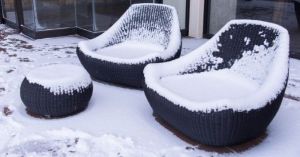Autumn is a beautiful time of year. The air is crisp, the trees are changing, and there are tons of fun activities to explore. One thing this time of year indicates, however, is that winter is just around the corner. Soon the days of bonfires, hikes, and apple picking will come to a close and the frost and chill of winter will set in. If you have an outdoor space you need to care for during the winter, there is a lot to prepare for before the cold season hits. Discover how to store outdoor furniture for the winter season.
Bring in Cushions and Other Non-Winterized Items
If possible, you should bring in items that can’t withstand snow, rain, ice, frost, or cold temperatures. Potted plants should be sprayed for bugs and be brought inside until the spring. Cushions on patio or other outdoor furniture should come in as well. These items can easily become stiffened or mold-ridden if left outside and unprotected. Winterizing your outdoor space is also a great opportunity to remove your outdoor cushion covers and wash them. With slipcovers on your outdoor cushions, washing them is a breeze. Bonus Tip: If you don’t have room to store your non-winterized items inside, consider a garage, storage unit, or even a quality deck box to store and protect your items from frost and moisture.
Rearrange Your Outdoor Setup for Impending Weather Changes
Winter can get windy. During the warmer months, it makes sense to have your outdoor area set up for conversation, play, and even bonfires or cookouts; however, in the winter, you most likely won’t be using your space that much. Stack chairs and move your tables and other outdoor furniture items to a central location, such as the corner of a patio or balcony. This helps keep all the items together and reduces the chance of them being blown around in a storm.
Cover the Items You Leave Outside
The items that will remain outdoors for the duration of the winter should be covered by a water-resistant covering such as a tarp or special patio furniture cover. This will help prevent moisture from getting on the items. Moisture can freeze to the furniture and cause rust over time, so it’s best to avoid unnecessary exposure to moisture when possible. There are many options when it comes to storing your outdoor furniture for the winter. Find what works best for you and be sure to winterize before the first frost!

